Java 9
- JPMS (Java Platform Module System) also known as Project Jigsaw
- benefits
- modularity as a first class citizen
- designing for modularity early
- new concepts, syntax, and tools
- modular platform
- smaller footprint
- benefits
- 5 pillars of modularity
- Encapulated: stronger encapsulation
- protection of a module's internals
- Interoperable: reliable modularity
- working with other modules
- Composable: reliable modularity
- modules can be combined with other modules
- Expandable: reliable modularity
- modules can be scaled up
- Autonomous: decomposable
- modules work independently of other modules
- Encapulated: stronger encapsulation
What it is trying to solve
Java 8
-
limited in terms of expressing modularity beyond a single package
-
once a class is public, there is no further way to control which classes in other packages can see it
- its all or nothing
-
path of the class that is stored on disk is intertwined with the package hierarchy
- means that how you organize the package hierarchies must be aligned with the accessibility that you want to assign to your class
-
example
-
1 package example works fine
- all packages are inside the movement package
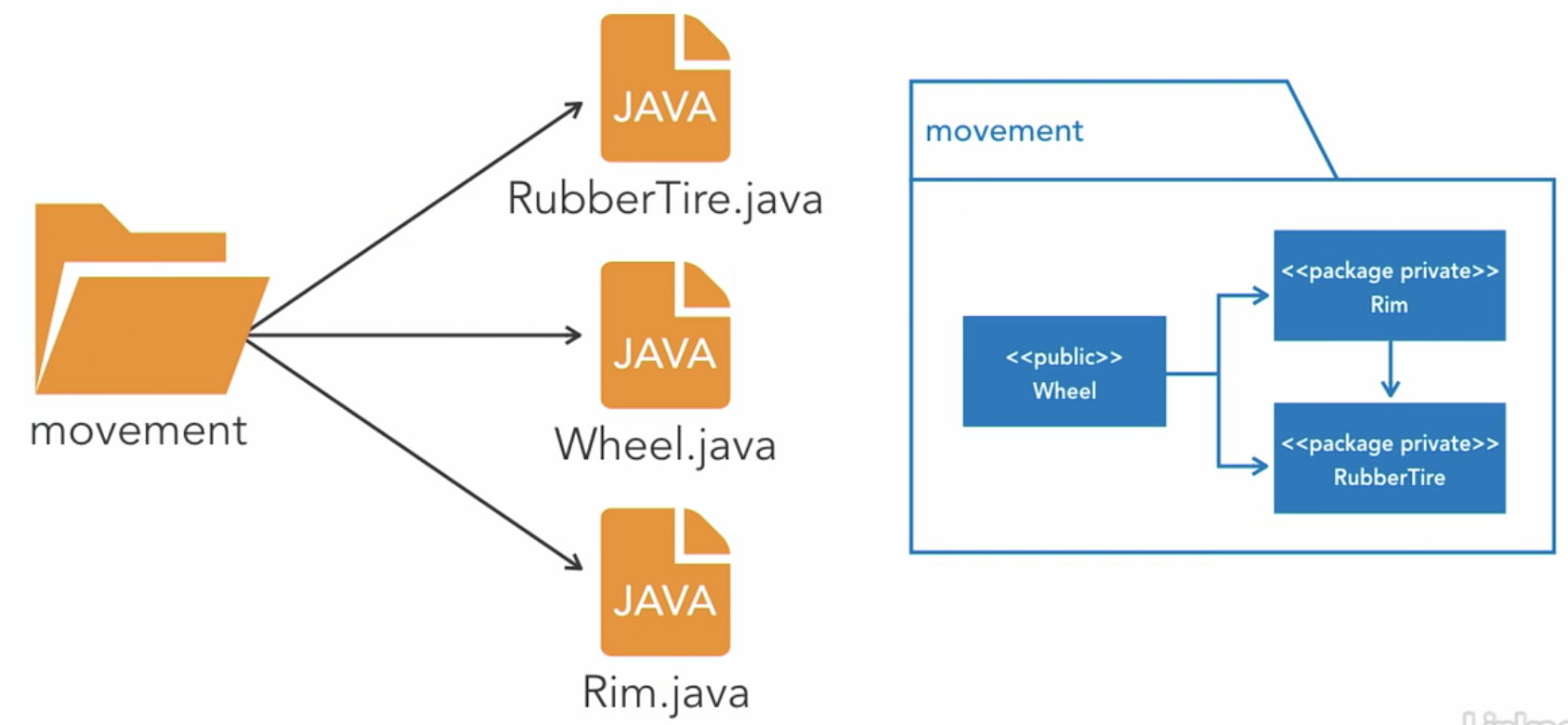
-
multiple packages example will not compile
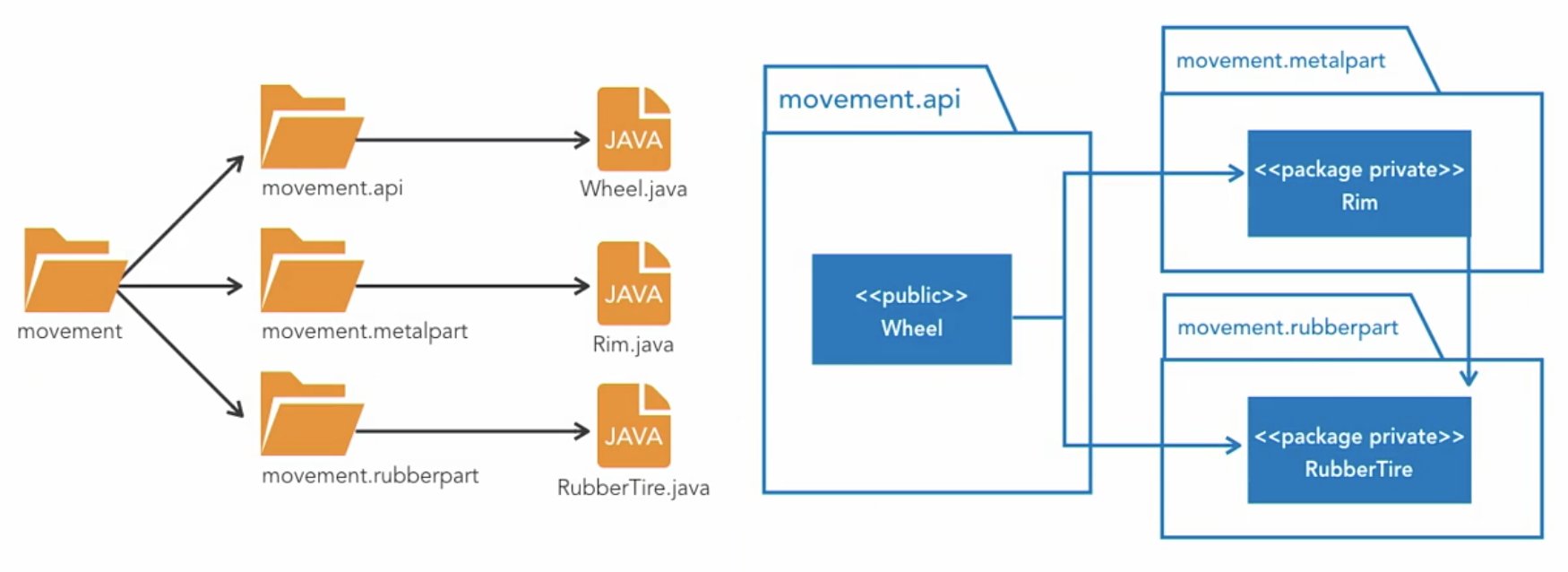
-
Java 9 improvements
-
class ccessibility
- JPMS offers better controls to expose classes
-
classpath hell
- JPMS maintains class integrity
- can be verified by static analysis
- support for versioning
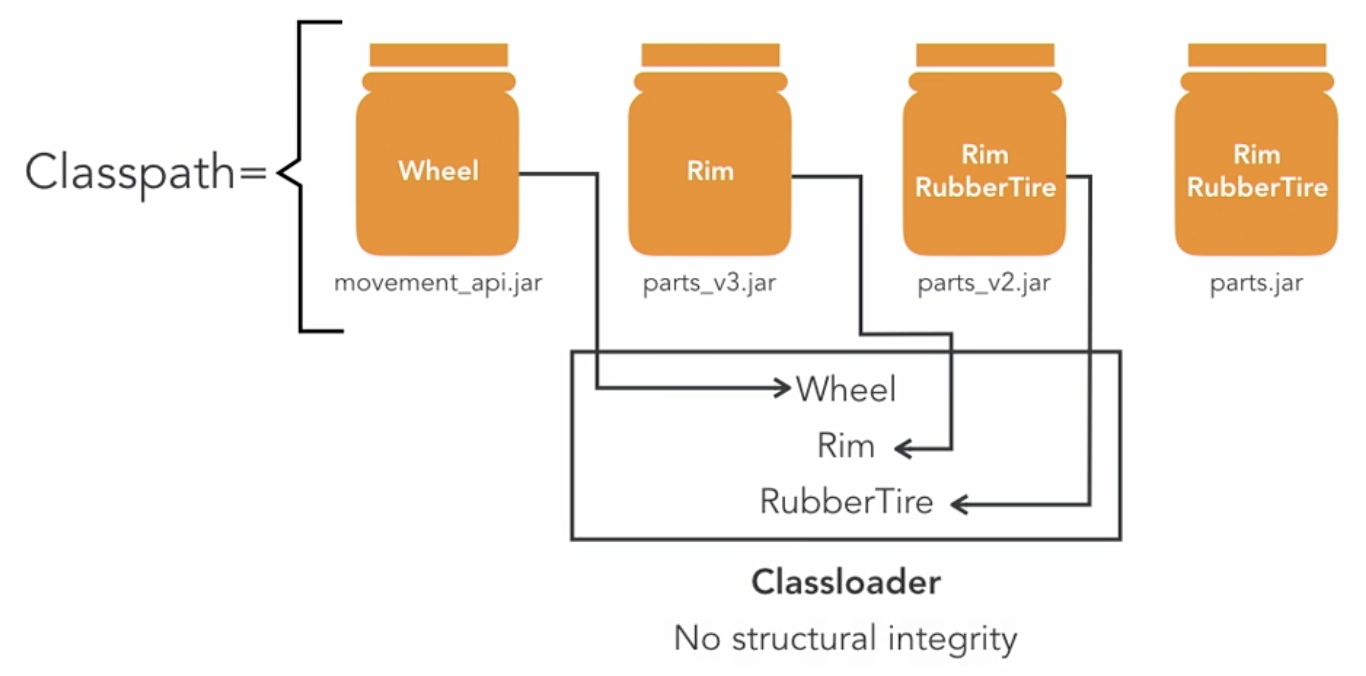
-
controlling the system footprint
- a large chunk of the JDK libraries were delivered as 1 big JAR file
rt.jar - by java 8, it had grown to over 66 MB of line code
- typical apps will not use all 66 MB, so why make all of it available at runtime
- thus the
rt.jarhas been modularized- libraries that used to eist in
rt.jarhave now been segmented into smallerJMODfiles- a new file format to package modules
- libraries that used to eist in
- a large chunk of the JDK libraries were delivered as 1 big JAR file
Module-info
- Regular java class
- Module-related syntax only
- module meta-data available at runtime
- providing fidelity across phrases
- 1 module-info per module
- declared at the root of module
- mandatory for JPMS
- creates a namespace for the module
- must be globally unique, like package names
- no duplication
- modules dictate how packages are stored on file system
- module hierarchies must match filesystem hierarchies
- segregated package hierarchies
- modules could each have their own codebase and lifecycles, but is not a must
- filename
module-info.javamodule module.name { // 1
exports package.name.a; // 2
exports package.name.b to other.module.name.a; // 3
requires other.module.name.b; // 4
}
Module name
- first line contains module keyword followed by module name
module.namein given example
- Module naming convention is similar to package convention
- reversed domain notation: domainName.module
- domain name: organization.com
- module: project
- module name in module-info:
com.organization.project
- reversed domain notation: domainName.module
Module API
- The second line declares that classes from a
package.name.amay be accessible for other modules - Module descriptor can export multiple packages, each on a separate line
Restricted API
- Line #3 declares that package
package.name.bis accessible only forother.module.name.a - This functionality should be use carefully, it brakes the rule that module knows only depended modules
- It also increases coupling of modules
Module dependency
- In the last line contains the information about the module dependencies
- In the provided example the
module module.namedepends onother.module.name.bmodule and has access to its exported packages - dependencies are enforced at run time
- apps fail if they can't resolve all of their dependencies
Transitive dependencies
- a transfer of dependencies to dependent modules
- in simpler terms
- every package a given module requires gets automatically passed to dependent modules
- in simpler terms
- it keep dependency graphs coherent
- it is a clean way to transfer dependencies to dependent modules
- but avoid having to repeat the dependency requirements
module module.name {
requires transitive other.module.name.b; // add transitive key word
}
-
from
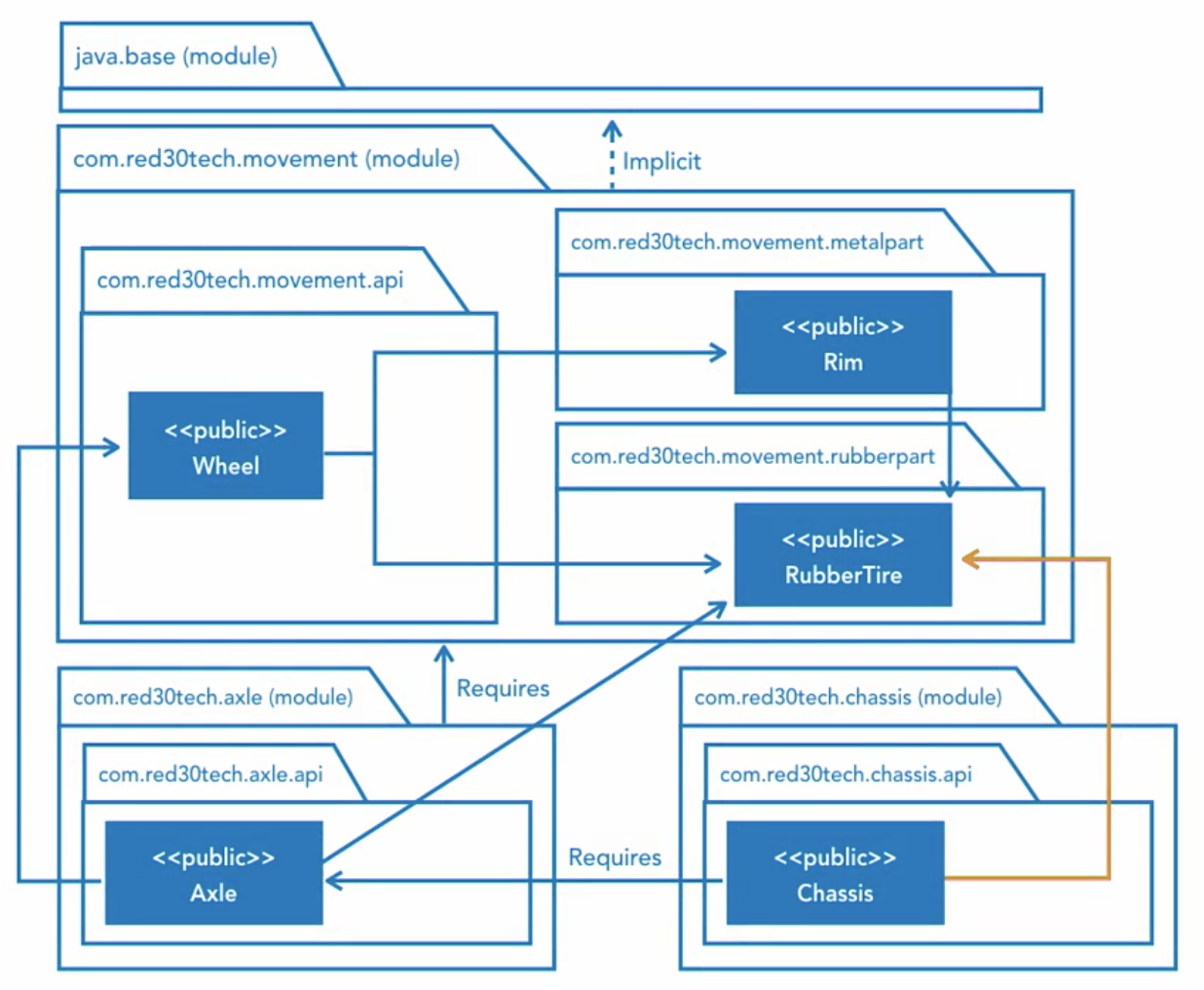
-
to
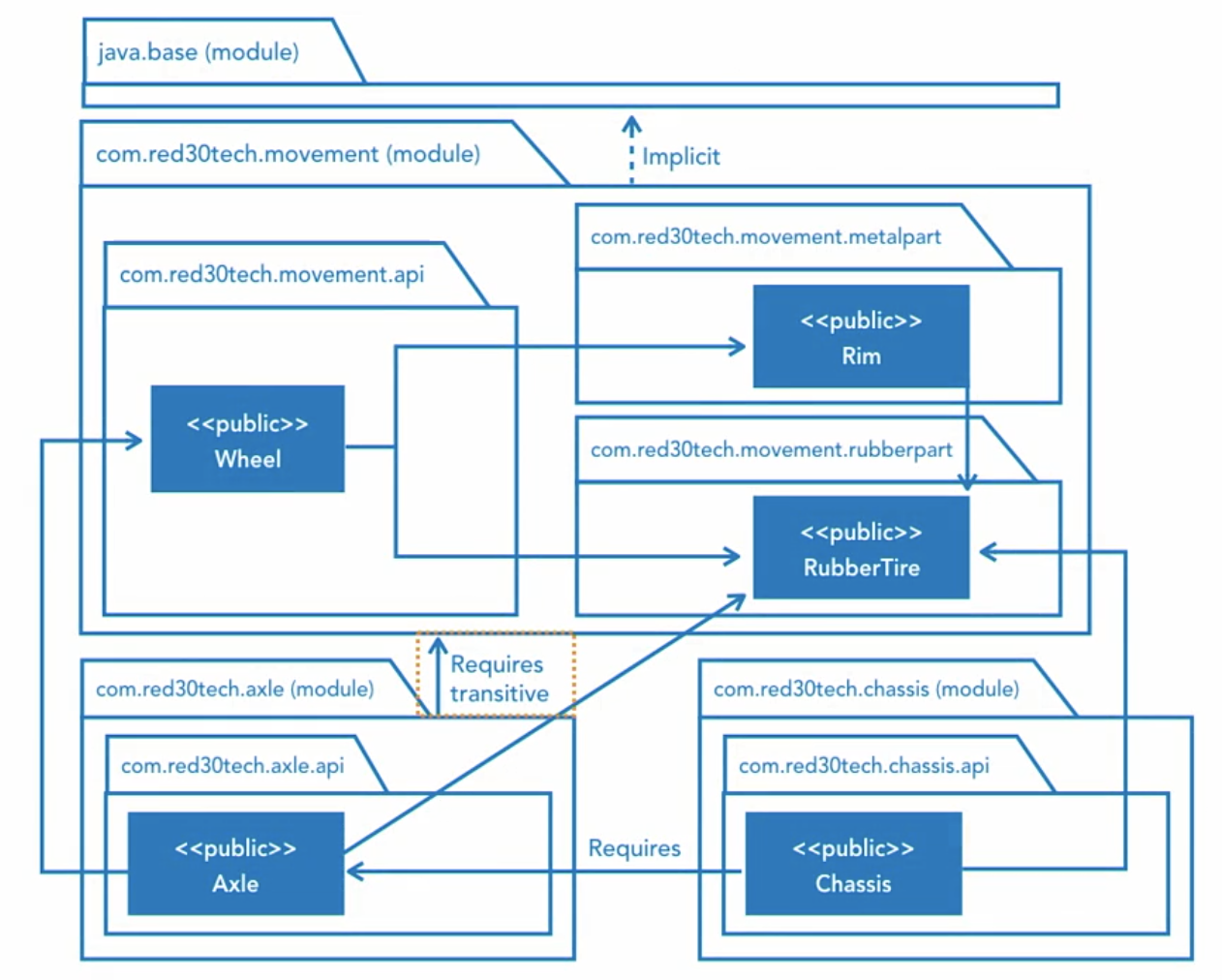
Qualified dependencies
-
exporting of packages to chosen modules
- similar to white listing approach to exporting
-
allow the exporting module to choose which foreign modules are allowed to read it
-
acts as a fine-grained filter, giving individual access at the package level
-
drawbacks of using qualified dependencies
- exporting modules should normally not know about which other modules are depending upon them
- qualified exports break this rule
- it should only be used in friend like contexts
- it is used because the modules are working closely with other modules to provide a functionality
- funcationalities are structured into independent modules
- but federated to act as 1 in providing that functionality
-
limitations to qualified dependencies
- it can't be used to grant readability to all forieng modules because they would all need to be known
- foreign modules must already exist, if not compilation will fail
-
qualified exporting should not be used as the default exporting tool
- but should be instead be used in special circumstances
- best used to give fine-grained access to known modules working together
-
problem
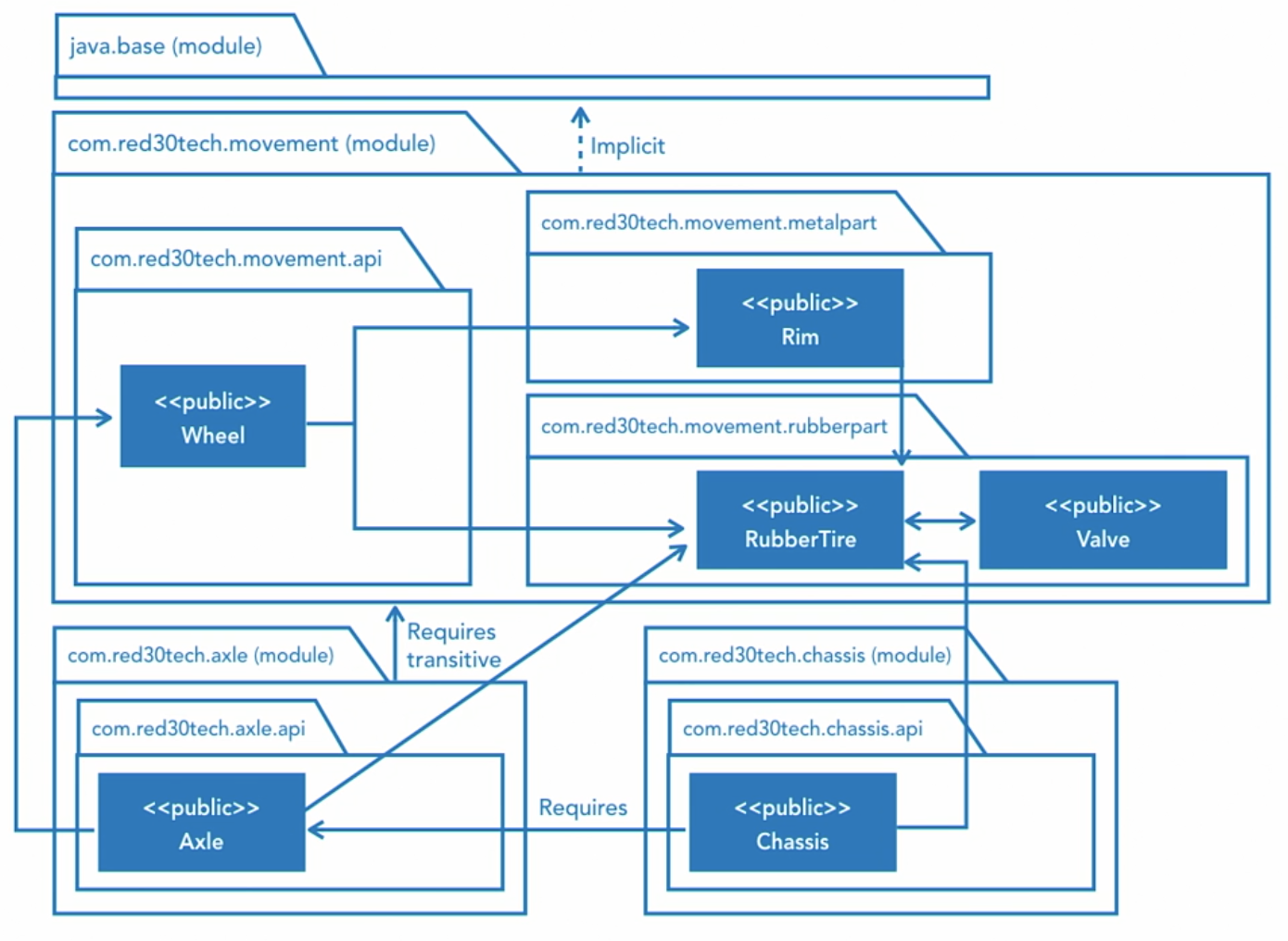
-
solution 1: changing accessibility from public to package private
- works if dependency does not require access from anywhere else
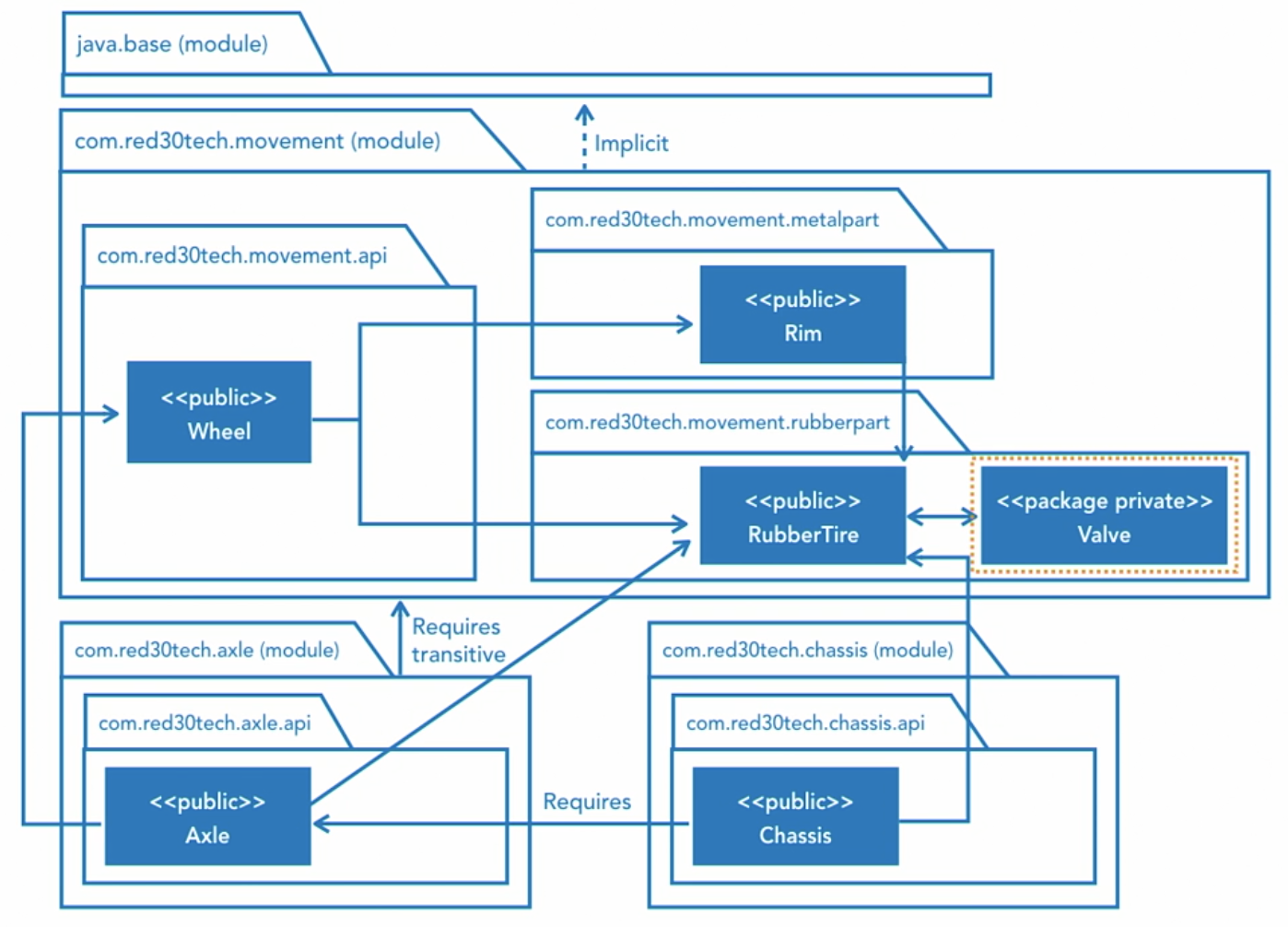
-
solution 2: refactor code
- is a hacky solution
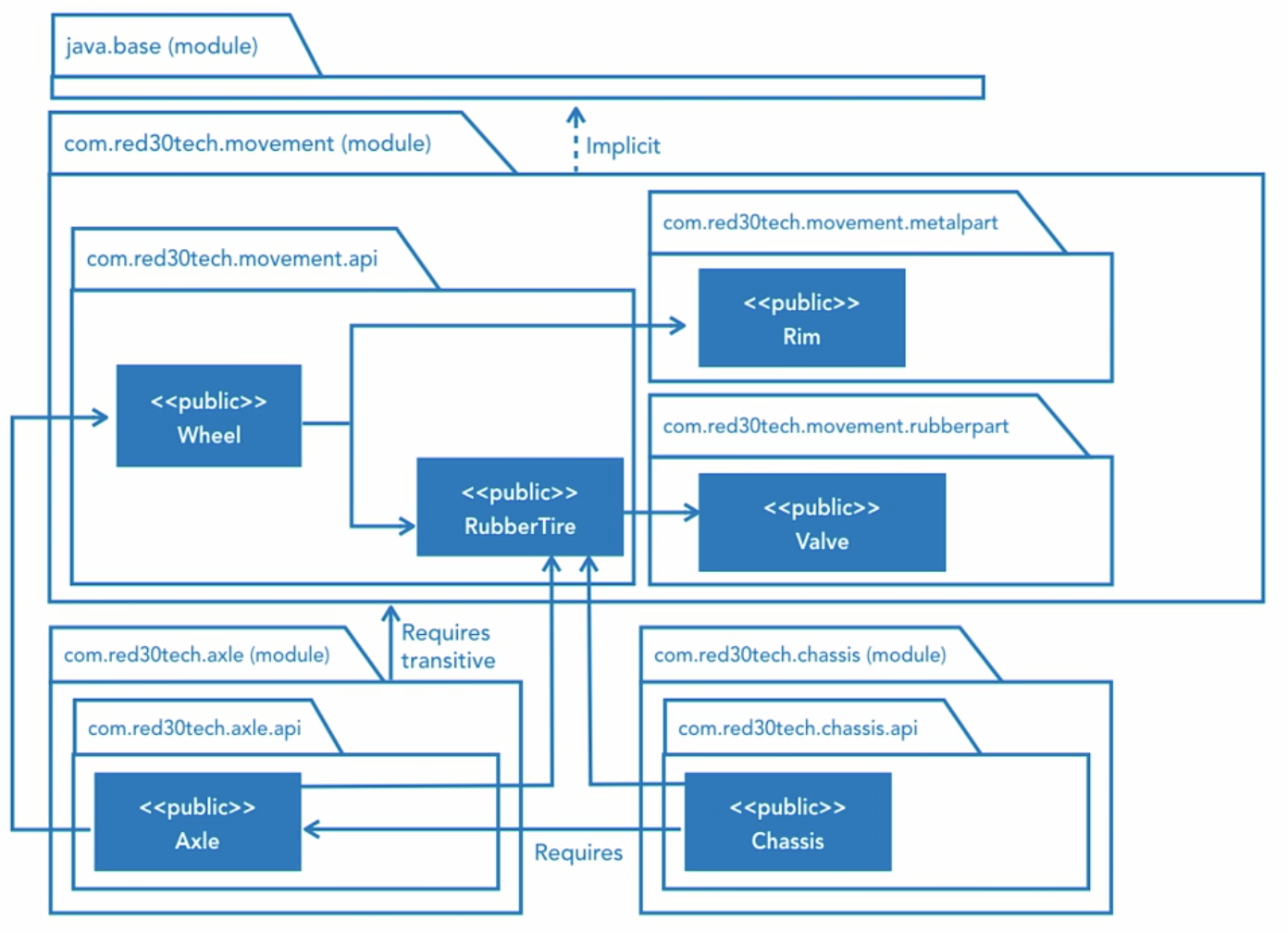
-
Proper solution:
- change accessibility from public to package private
- use the
tokey word inmodule-info.javafile
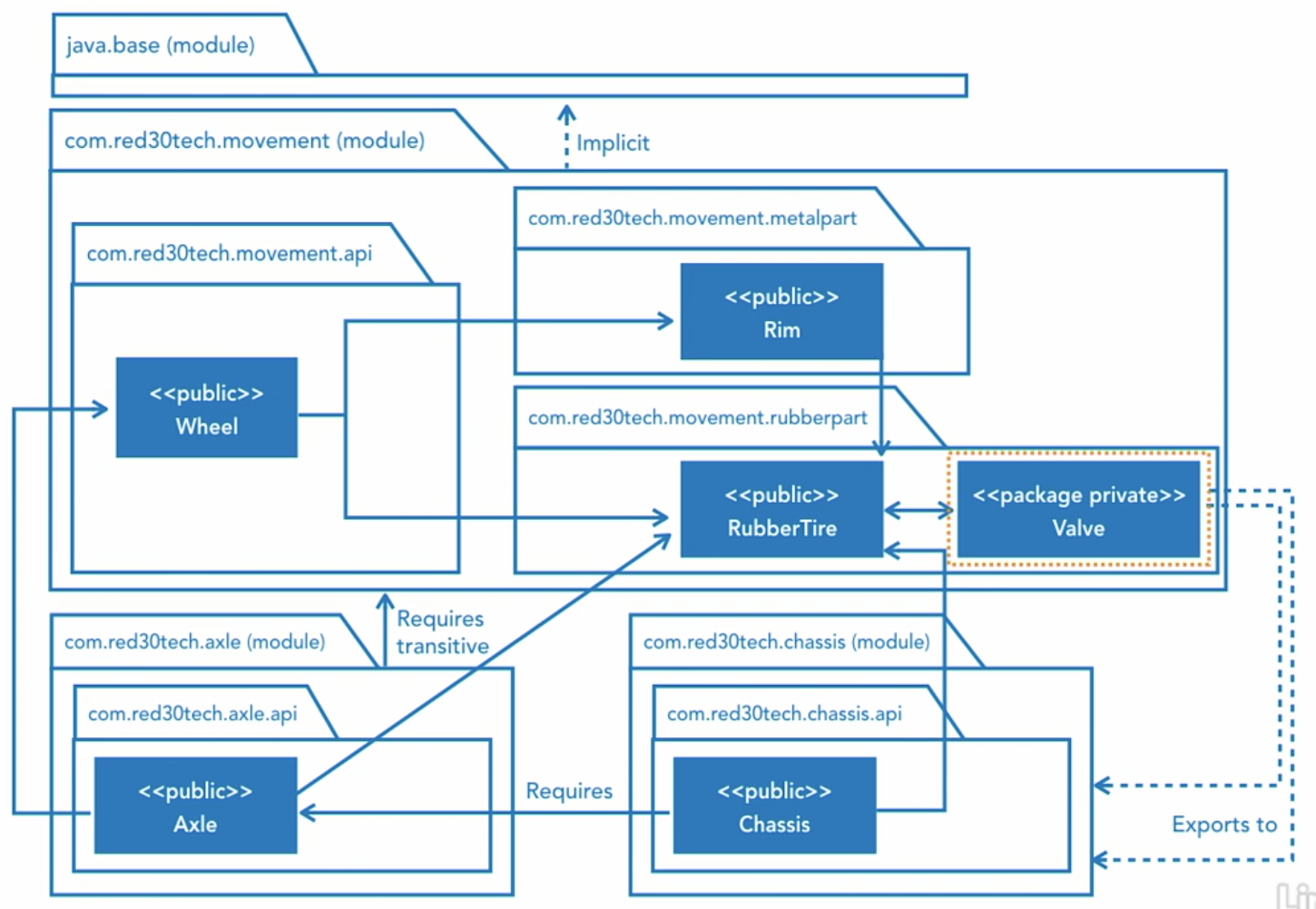
module module.name {
exports package.name.b to other.module.name.a, other.module.name.c, ...; // use the to key, can export to multiple packages
}
Service dependencies
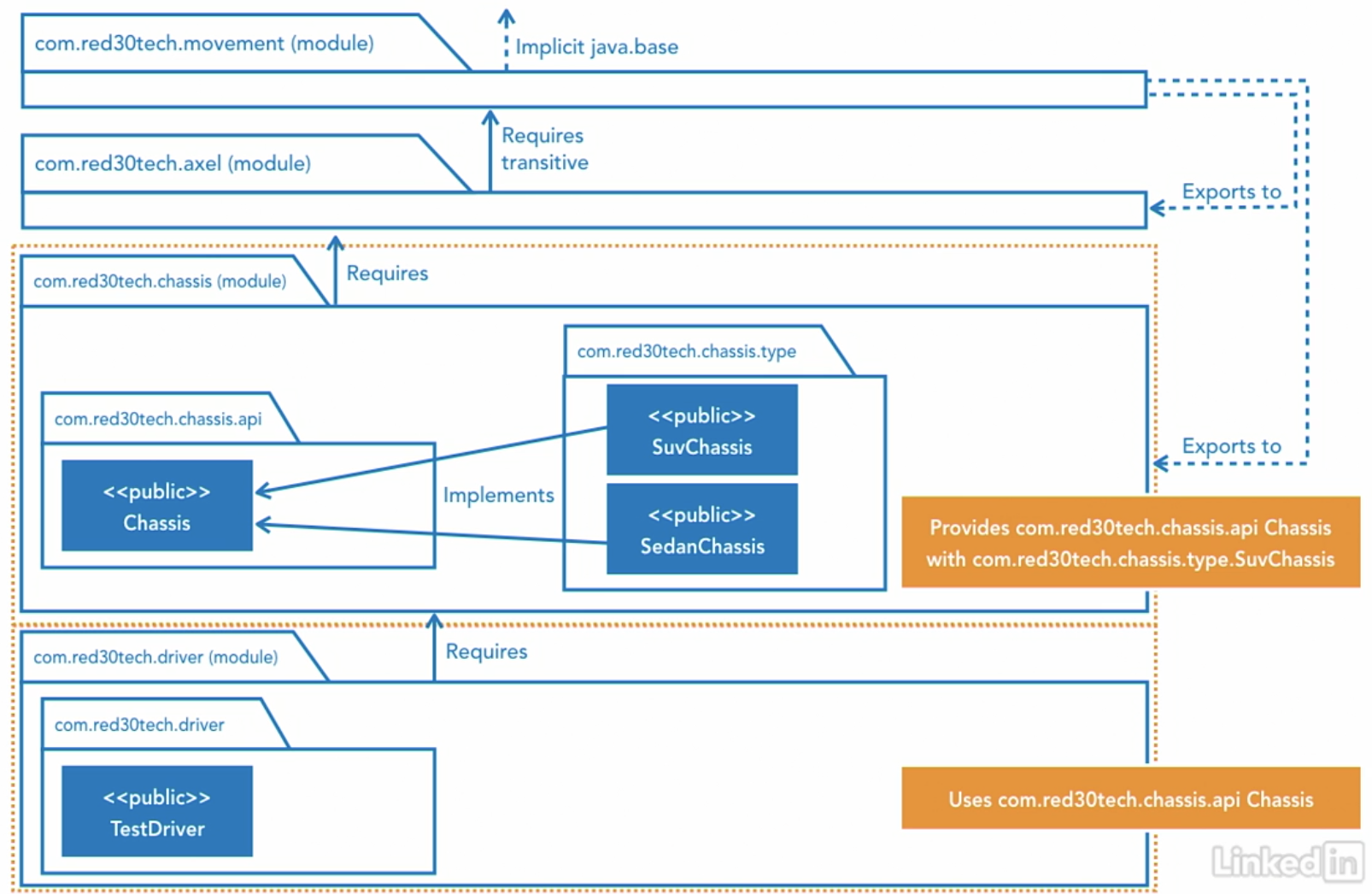
-
service provider
- has an interface where multiple types implements it
- in the
module-info.javafilemodule module.name {
exports package.name.a;;
provides package.name.a.InterfaceName with // interface
package.name.a.type.One; // class that implements interface
package.name.a.type.Two; // can provide multiple classes that implements the interface
...
}
-
service consumer
module module.name.b {
requires package.name.a;
uses package.name.a.InterfaceName; // only interface is specified
}-
service loader
- pluggable services framework
- binds service providers to consumers
- not new, but enhanced for JPMS
- does not replace dependency injection frameworks
- but can be used in apps that need to deliver functionality in a modular and interoperable way without using third party frameworks
- ideal for stand-alone jave SE apps
- example: a class that uses the service loader to obtain an instance to one of the interface implementations
import java.util.ServiceLoader;
import java.util.Optional;
import com.red30tech.chassis.api.InterfaceName;ServiceLoader<InterfaceName> serviceLoader = ServiceLoader.load(InterfaceName.class);
System.out.println("Found " + serviceLoader.stream().count() + " interface name configured"); // count depends on number of classes implemented with interface that are provided in the modular-info.java file
Optional<InterfaceName> optional = serviceLoader.findFirst();
optional.orElseThrow(() -> new RuntimeException("No service providers found"));
InterfaceName interfaceName = optional.get();
-
Optional dependencies
- mandatory at compilation time, but optional at run time
- the interface can now add an option to enable or disable the implementation of the optional dependencies
- optional dependencies must be coded defensively
- must use with
try/catchand withNoClassDefFoundErrorexception
- must use with
- optinal modules become regular modules if they get required by other modules in the graph
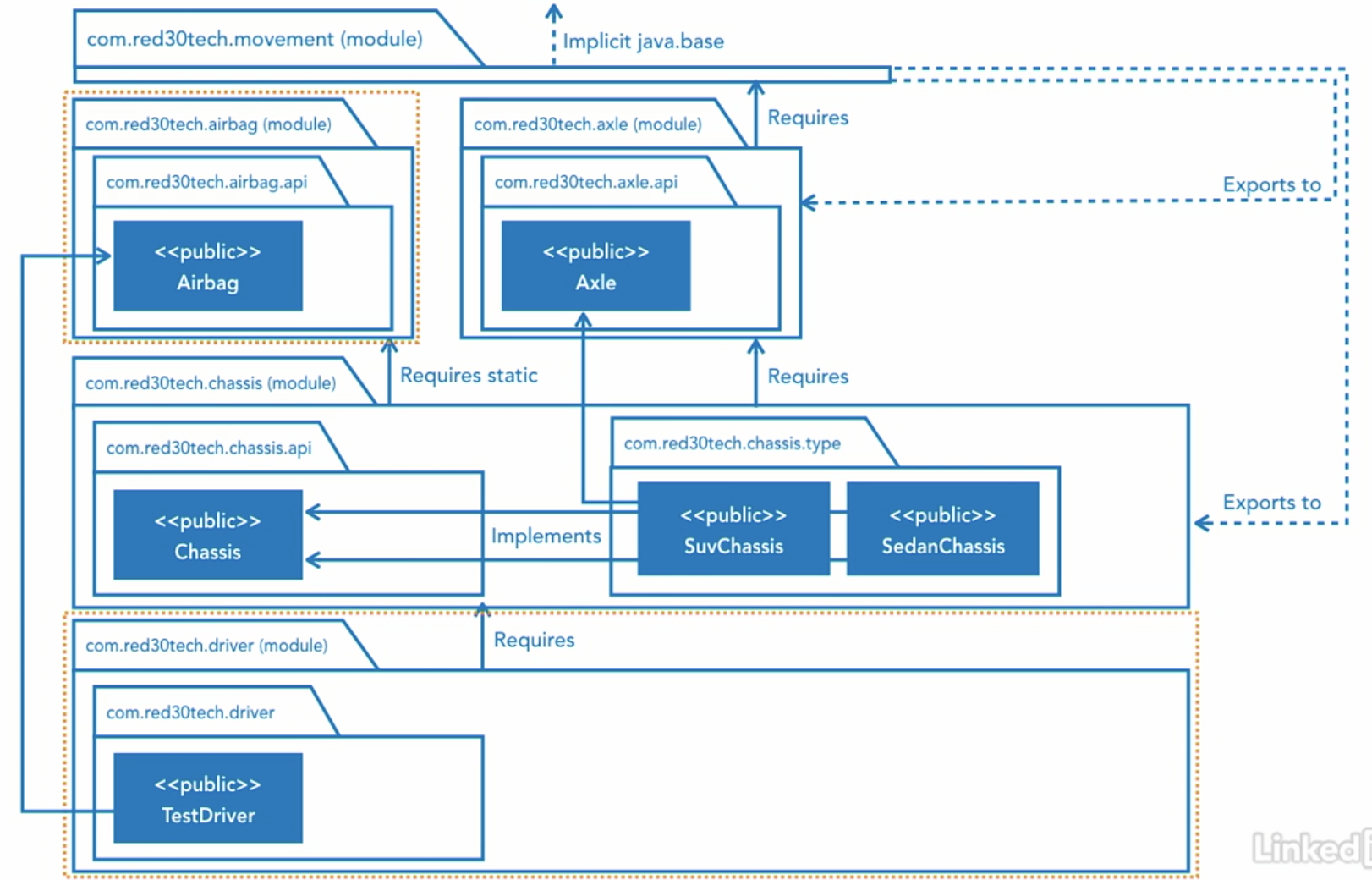
moduel module.name {
requires package.name.b;
requires static package.name.c; // use the static keyword to make it optional
exports package.name.a;
provides package.name.a.InterfaceName with
package.name.a.type.One;
package.name.a.type.Two;
}
try {
OptionalDependencyName a = new OptionalDependencyName();
} catch (NoClassDefFoundError exception) {
a = null;
}
# run without optional dependency
java --module-path mods/ -m com.domain.module/com.domain.module.Main
# run with optional dependency
java --module-path mods/ --add-modules com.domain.optionalmodule -m com.domain.module/com.domain.module.Main
Runtime dependencies
- API misuses are caught at compilation time
- by not exporting the package
- the package won't be readable by foreign modules
- by not exporting the package
- if a dependency was not exported
- importing or instantiating the dependency will cause a compilation error
- reflection-based framework
- not importing but using the type without instantiating will allow compilation but fails at runtime
Open dependencies
- allows module access at run time only (via reflection)
- compile time access is closed
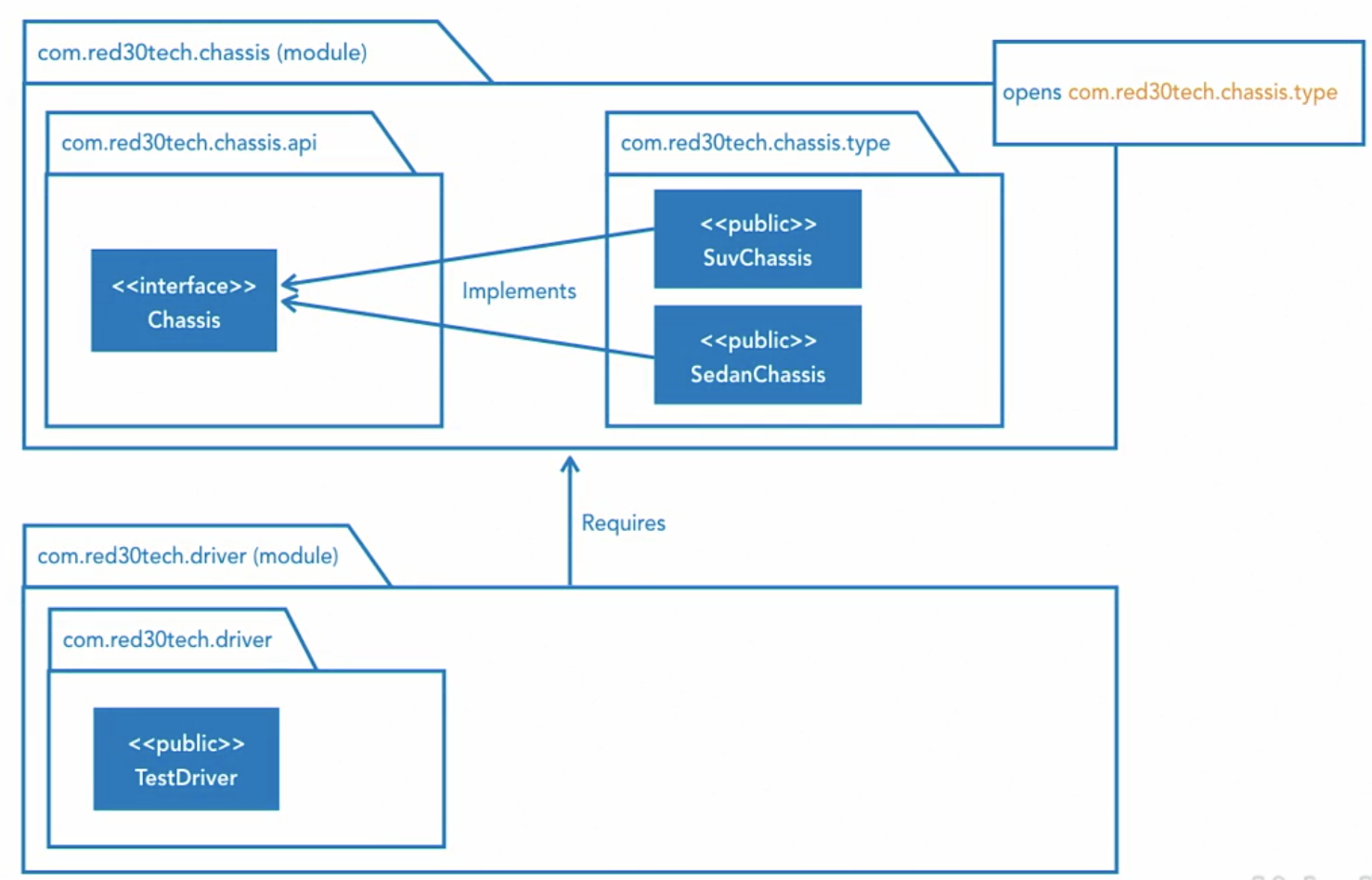
moduel module.name {
requires package.name.b;
requires static package.name.c;
exports package.name.a;
opens package.name.a.type; // use the opens keyword to allow reflection-based access at run time to all classes
provides package.name.a.InterfaceName with
package.name.a.type.One;
package.name.a.type.Two;
}
Rules of modularization
- Firstly
- cycles between modules (on compilation level) are prohibited
- It’s a limitation but no one should cry because of that
- Cycles in general are sign of a bad design
- Secondly, even if module encapsulation is controlled on compile and runtime level
- you can brake it using reflection API and freely use debug tools
- Thirdly, all modules have an implicit dependency to
java.basemodule and it doesn’t have to be specified in module descriptor- The implicit dependency on
java.baseis similar to implicit import ofjava.lang.Stringclass
- The implicit dependency on
- Fourthly, due to backward compatibility, every class not placed in the modules goes to unnamed module
- That module has dependency to all other modules and has access to the packages which they exported
- It’s important that not exported packages are not accessible
- Since Java 9 some APIs are marked as internal and are unavailable from regular packages
- If you compile code using such packages in Java 8 and try to use it with Java 9, you’ll get runtime error
Modular structure design
- small apps may have just 1 module
- 9 tips
- Token modularization
- package non-modular classes into jars and use automatic modules
- automatic jars can be read and depended upon by modules
- gateway to modular java
- Piecemeal Modularization
- modularizing large code bases is a big undertaking
- use a piecemeal approach
- start with root packages, such as utility
- can be read by unnamed modules
- modularizing large code bases is a big undertaking
- use modularity for better design
- modularity helps detect hidden bad designs
- cyclic dependencies, lack of interfaces, and packages that try to do too much
- take the opportunity to refactor during modularization
- Break Monoliths along Natural Fault Lines
- consider module boundaries in tiers
- front-end/back-end/persistence
- mobile, web, and desktop
- relational vs document vs graph databases
- Keep Private Things Private
- modules are the next level of lexical scope
- hide classes that shouldn't be exposed
- identify the export package
- put public classes there
- leads to better APIs
- OSGi Status Quo
- future of OSGi integration is not clear
- JPMS offers native modularity
- hold off JPMS until there is clarity with OSGi integration
- Complement Microservices with JPMS
- introduce JPMS to your microservices architecture
- JPMS will provide better encapsulation and the next level of lexical scoping
- better code hygiene
- focus on larger services
- Use the Tools to Deliver Software
- introduce the static analysis tools in your build process
- Jdeps, java -dry-run, jdeprscan
- used to produce metrics and quality software
- All Things in Moderation
- don't over-modularize
- over-modularized code is worse than a monolith
- understand the dependencies in your package
- Token modularization
JPMS introduces the module path
-
it tells the compiler and runtime where to find the modules
-
directory hierarchy must match module/package hierarchy
- each module is a separate hierarchy
-
the module path supersedes the class path
- the class path is for backward compatibility
-
the module path can aggregate many modules
- each module can be its own island of code
-
1 modular structure
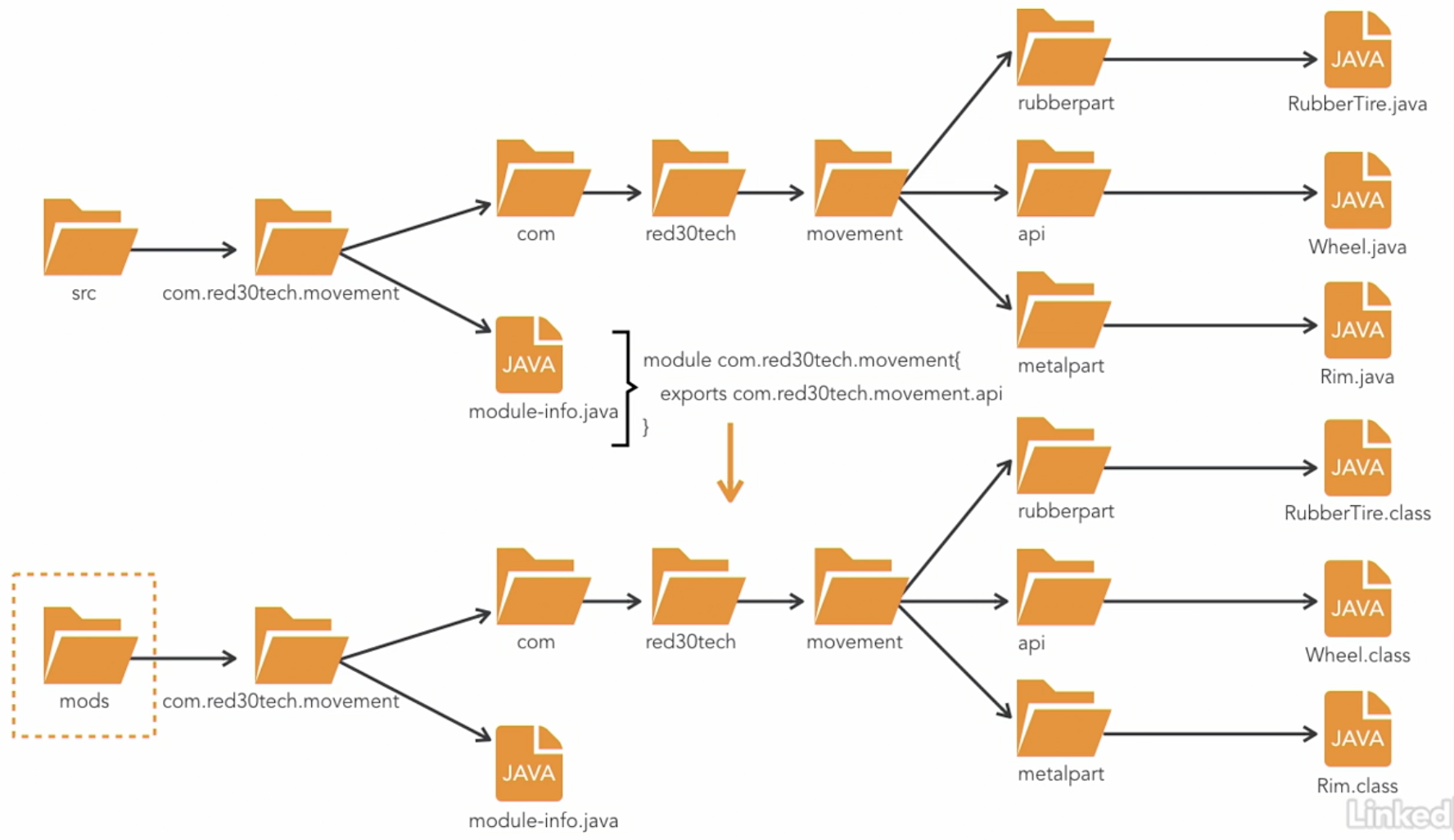
-
multi modular structure
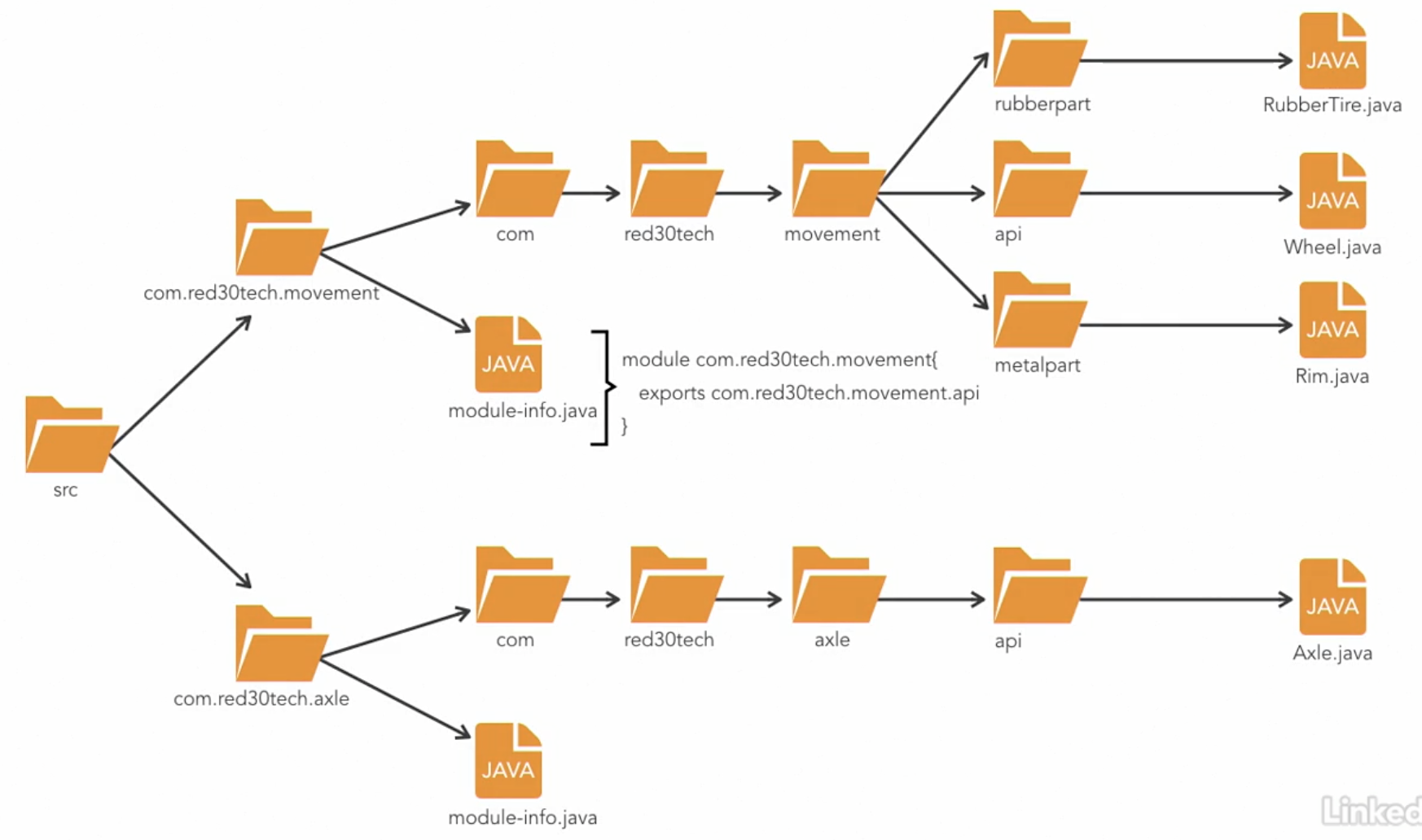
Tools and Strategies
javac
javac -d ./mods/ --module-source-path src $(find src -name "*.java")javac -d ./mods/ --module com.domain.module --module-source-path srcjavac -d ./mods/ --module-path mods --module com.domain.module --module-source-path src- build with version
javac -d ./mods/ --module-source-path src --module-version 123.01 $(find src -name "*.java")
Jar
-
a jar file that contains module-info at its root
-
a module is 1 to 1 with a jar file
-
build
rm -rf bin
mkdir bin
javac -d ./mods/ --module-source-path src $(find src -name "*.java")
find src -name "*.java"
jar --create --file ./bin/com.domain.modulea.jar -C mods/com.domain.modulea .
jar --create --file ./bin/com.domain.moduleb.jar -C mods/com.domain.moduleb . -
build with versioning
rm -rf bin
mkdir bin
javac -d ./mods/ --module-source-path src $(find src -name "*.java")
find src -name "*.java"
jar --create --file ./bin/com.domain.modulea.jar --module-version=123.02 -C mods/com.domain.modulea .
jar --create --file ./bin/com.domain.moduleb.jar -C mods/com.domain.moduleb . -
run
java --module-path bin -m com.domain.modulea/com.domain.modulea.ClassName
Dependency checking tools
- describe module
- describe modules used and their dependencies without running the program
java --module-path mods/ --describe-module com.domain.modulea
- describe modules used and their dependencies without running the program
- list modules
- list all of the observable modules
- observable modules are modules that are available at run time
- but not necessarily the ones used by the application
java --module-path mods/ --list-modules com.domain.modulea
- list all of the observable modules
- show module resolution
- shows how modules are resolved before running the application
- will include both the JDK library modules and the application modules
- will also run the application
java --module-path mods/ --show-module-resolution -m com.domain.modulea/com.domain.modulea.ClassName
- dry run
- to make sure application will resolve all dependencies without actually running the app
- an error will occur if module does not exist
java --module-path mods/ --dry-run -m com.domain.modulea/com.domain.modulea.ClassName
- upgrade version at run time
- build first version
javac -d ./mods/ --module-version 123.01 --module-source-path src $(find src -name "*.java")
- build second version
javac -d ./mods2/ --module-version 123.02 --module com.domain.modulea --module-source-path src
- run with upgraded version
java --upgrade-module-path mods2 --module-path mods -m com.domain.modulea/com.domain.modulea.ClassName
- build first version
Jdeps
- a class dependency analyzer tool
- check dependencies
- prints the dependencies between each module
jdeps --module-path mods/ mods/com.domain.modulea
- prints the dependencies between each module
- list jdeps
- print a summarized list of dependencies
jdeps --list-deps --module-path mods/ mods/com.domain.modulea
- print a summarized list of dependencies
Module packaging tools
Jmod
-
a tool and a file format
-
it creates jmod files
-
similar in intent as jar files, but designed to work with
Jlink -
used to build custom runtime images
-
pre-java9
- 1 jar file as
rt.jarcontains all JDK libraries - causes longer time to start
- not suitable for small apps with very short lifecycle
- 1 jar file as
-
build jmods
rm -rf jmods jlink
mkdir jmods
javac -d ./mods/ --module-source-path src $(find src -name "*.java")
jmod create jmods/com.domain.modulea.jmod --class-path mods/com.domain.modulea
jmod create jmods/com.domain.moduleb.jmod --class-path mods/com.domain.moduleb -
list jmod contents
jmod list jmods/com.domain.modulea.jmod
-
describe jmod contents
jmod describe jmods/com.domain.modulea.jmod
-
extract classes from jmod contents
jmod extract jmods/com.domain.modulea.jmod
Custom image building tools
Jlink
-
a tool to create custom runtime images
-
self-contained images that include the JRE
-
it contains everything needed to run, no pre-installing of Java Runtime on the host is required
-
it strips away everything from the JDK that isn't used by the app
- results in a smaller overall app distribution
-
build jlink from jmod
rm -rf jmods jlink
mkdir jmods
javac -d ./mods/ --module-source-path src $(find src -name "*.java")
jmod create jmods/com.domain.modulea.jmod --class-path mods/com.domain.modulea
jmod create jmods/com.domain.moduleb.jmod --class-path mods/com.domain.moduleb
jlink --module-path $JAVA_HOME/jmods:jmods --add-modules com.domain.modulea --output jlink --launcher run=com.domain.modulea/com.domain.modulea.ClassName -
run jlink
jlink/bin/run
Jmod hasing
-
a hash is a tag that marks interrelated Jmod files ensuring they are used together
-
it prevents files from different tags to be interchanged
-
hash jmod
rm -rf jmods jlink
mkdir jmods
javac -d ./mods/ --module-source-path src $(find src -name "*.java")
jmod create jmods/com.domain.modulea.jmod --class-path mods/com.domain.modulea
jmod create jmods/com.domain.moduleb.jmod --class-path mods/com.domain.moduleb
jmod hash --module-path jmods --hash-modules .*
jlink --module-path $JAVA_HOME/jmods:jmods --add-modules com.domain.modulea --output jlink --launcher run=com.domain.modulea/com.domain.modulea.ClassName -
view hash with describe
jmod describe jmods/com.domain.modulea.jmod
Jar files vs Jmod files
| jar files | jmod files |
|---|---|
| support modules | use for custom run time image |
| use for running on a pre-installed JRE | can hold native libraries |
| use for packaging on custom images |
backward compatibility with classes
Jdeprscan
- a static analysis tool that scans code for uses of deprecated API elements
- use to show every method in the standard JDK libraries that have been deprecated or slated for removal
- scan jdk libraries
jdeprscan --list --release 6
- list jdk libraries for removel
jdeprscan --list --for-removal
- scan classes
jdeprscan --class-path classes classes
Explicit vs unamed modules
-
the module path is always searched first when loading classes, and if it's not found there, the class path is searched, so classes and modules can coexist
-
All nonmodule classes loaded from the class path are part of what is called the unnamed module
-
The unnamed module is a new concept created to bridge modularized and unmodularized code
-
Explicit modules are those defined via the module-info class
-
Unnamed modules are special modules created by their runtime that contain all classes that are loaded from the class path
-
At most, there will be only one unnamed module at runtime
-
Classes within the unnamed module can read any public class from an exported package of an explicit module
- But the reverse is not true
-
Explicit modules cannot read the classes from the unnamed module, nor can they depend upon the unnamed module
-
unnamed modules exist only for interoperability between modularized and unmodularized code
- This means that the axle class can access anything that the movement module exports without explicitly requiring it
-
if a package is defined in both the class path and the module path, then the class found in the module is loaded
-
These readability rules are important to preserve reliable configuration in JPMS
-
Otherwise, JPMS would be broken
-
These constructs exist for backward compatibility and not as an end state
-
While unnamed modules can participate in JPMS, they are second-class citizens in the world of modularity because they can't fully take advantage of all the features
-
build unnamed module
- src_1 has no
module-info.javafile- however, the classes inside can still import from src_2
rm -rf mods bin classes
mkdir mods bin classes
javac -d ./mods/ --module-source-path src_2 $(find src_2 -name "*.java")
javac -d ./classes/ -cp mods/com.domain.moduleb --source-path src_1 $(find src_1 -name "*.java")
jar --create --file ./bin/com.domain.moduleb.jar -C mods/com.domain.moduleb . - src_1 has no
-
run unnamed module
java --module-path bin --add-modules ALL-MODULE-PATH -cp classes com.domain.modulea.ClassName
backward compatibility with JARs
Automatic modules
- a jar that was created from unmodularized code doesn't have the module info class but can still be used within JPMS
- created by the platform to hold classes loaded from a non-modular jar
- classes loaded from non-modular jars are contained by the platform inside automatic modules
- it helps with the in between world of partially modularized code bases and libraries
- it offer better integration with modules
- but still is limited because they cannot depend upon explicit modules
- together with unnamed modules, they allow piecemeal migration to modules
- and avoid a big bang migration approach
- it is class exclusive
- this means that if a class exists in 2 different jar files
- only 1 jar file will be used as automatic
- the other jar will be discarded in its entirety
- this means that if a class exists in 2 different jar files
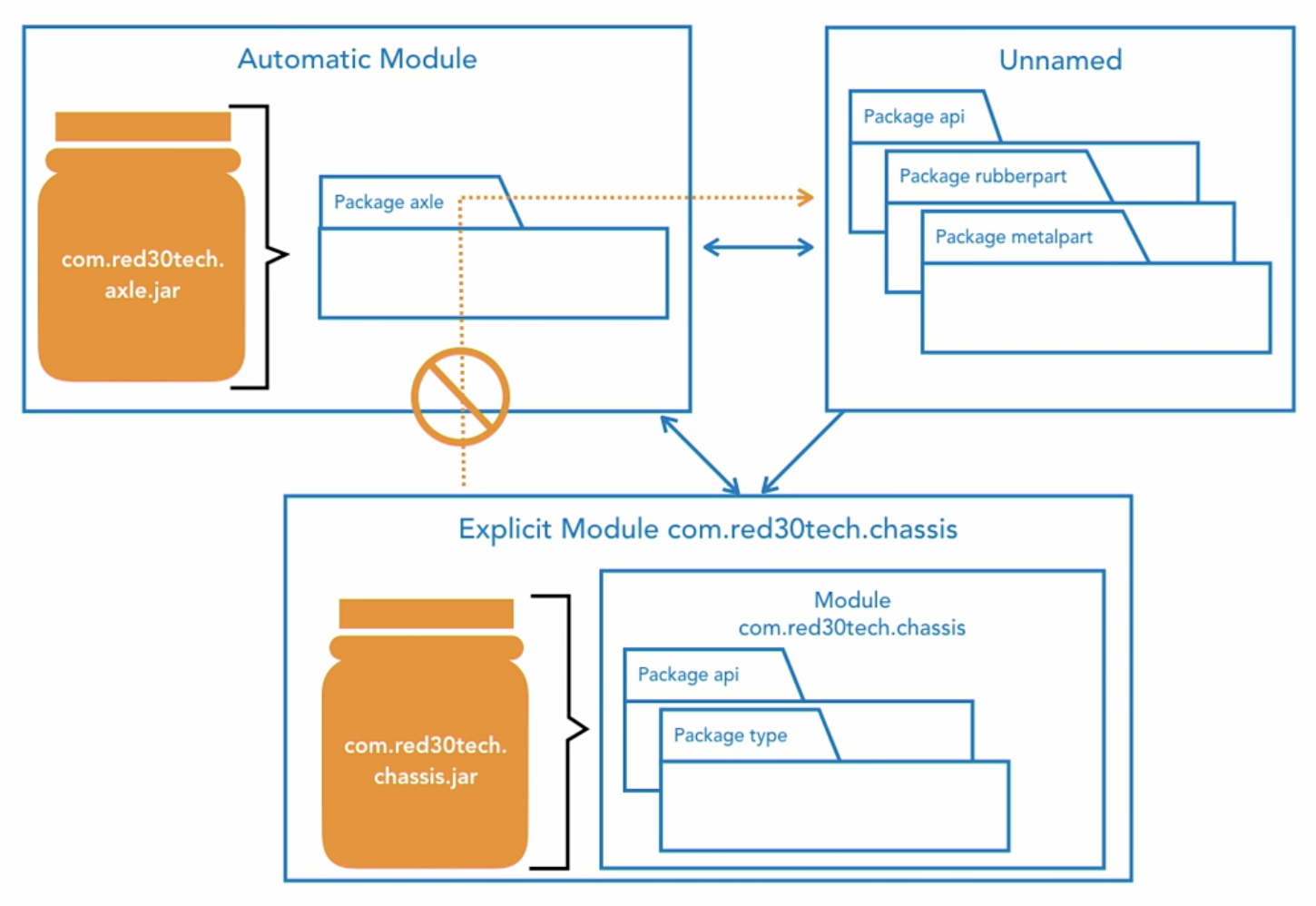
-
build automatic module
- src_1 has no
module-info.javafile- however, the classes inside can still import from src_2
rm -rf mods bin classes
mkdir mods bin classes
javac -d ./mods/ --module-source-path src_2 $(find src_2 -name "*.java")
javac -d ./classes/ -cp mods/com.domain.moduleb --source-path src_1 $(find src_1 -name "*.java")
jar --create --file ./bin/com.domain.moduleb.jar -C mods/com.domain.moduleb .
jar --create --file ./bin/com.domain.modulea.jar -C classes . - src_1 has no
-
run automatic module
java --module-path bin --add-modules ALL-MODULE-PATH com.domain.modulea.ClassName